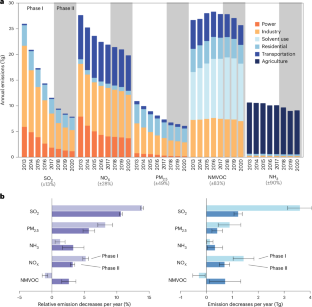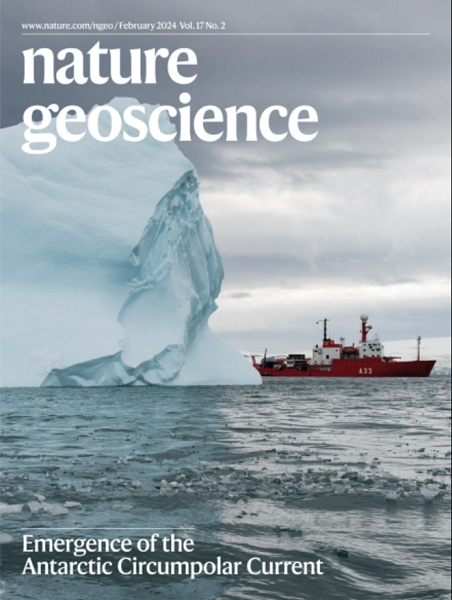Efficacy of China’s clean air actions to tackle PM2.5 pollution between 2013 and 2020
IF 15.7
1区 地球科学
Q1 GEOSCIENCES, MULTIDISCIPLINARY
引用次数: 0
Abstract
Beginning in 2013, China launched two phases (2013–2017 and 2018–2020) of clean air actions that have led to substantial reductions in PM2.5 concentrations. However, improvement in PM2.5 pollution was notably slowing down during Phase II. Here we quantify the efficacy and drivers of PM2.5 improvement and evaluate the associated cost during 2013–2020 using an integrated framework that combines an emission inventory model, a chemical transport model and detailed cost information. We found that national population-weighted mean PM2.5 concentrations decreased by 19.8 μg m−3 and 10.9 μg m−3 in the two phases, and the contribution of clean air policies in Phase II (2.3 μg m−3 yr−1) was considerably lower than that of Phase I (4.5 μg m−3 yr−1), after excluding the impacts from meteorological condition changes and COVID-19 lockdowns. Enhanced structure transitions and targeted volatile organic compounds and NH3 reduction measures have successfully reduced emissions in Phase II, but measures focusing on the end-of-pipe control were less effective after 2017. From 2013 to 2020, PM2.5 abatement became increasingly challenging, with the average cost of reducing one unit of PM2.5 concentration in Phase II twice that of Phase I. Our results suggest there is a need for strengthened, well-balanced, emission control strategies for multi-pollutants. China’s second phase of clean air actions proved less effective than the first, highlighting the need to adapt and update policies to enable continued progress, according to an assessment combining chemical transport modelling and emission inventories.


2013年至2020年中国清洁空气行动在解决PM2.5污染方面的成效
从 2013 年开始,中国启动了两个阶段(2013-2017 年和 2018-2020 年)的清洁空气行动,使 PM2.5 浓度大幅下降。然而,在第二阶段,PM2.5污染的改善速度明显放缓。在此,我们利用排放清单模型、化学传输模型和详细成本信息相结合的综合框架,量化了 PM2.5 改善的效果和驱动因素,并评估了 2013-2020 年期间的相关成本。我们发现,在两个阶段,全国人口加权平均 PM2.5 浓度分别下降了 19.8 μg m-3 和 10.9 μg m-3,在排除气象条件变化和 COVID-19 锁定的影响后,第二阶段清洁空气政策的贡献(2.3 μg m-3 yr-1)大大低于第一阶段(4.5 μg m-3 yr-1)。强化结构转换和有针对性的挥发性有机化合物和 NH3 减排措施成功减少了第二阶段的排放量,但侧重于末端控制的措施在 2017 年后效果较差。从 2013 年到 2020 年,PM2.5 的减排变得越来越具有挑战性,第二阶段减少一个单位 PM2.5 浓度的平均成本是第一阶段的两倍。
本文章由计算机程序翻译,如有差异,请以英文原文为准。
求助全文
约1分钟内获得全文
求助全文
来源期刊

Nature Geoscience
地学-地球科学综合
CiteScore
26.70
自引率
1.60%
发文量
187
审稿时长
3.3 months
期刊介绍:
Nature Geoscience is a monthly interdisciplinary journal that gathers top-tier research spanning Earth Sciences and related fields.
The journal covers all geoscience disciplines, including fieldwork, modeling, and theoretical studies.
Topics include atmospheric science, biogeochemistry, climate science, geobiology, geochemistry, geoinformatics, remote sensing, geology, geomagnetism, paleomagnetism, geomorphology, geophysics, glaciology, hydrology, limnology, mineralogy, oceanography, paleontology, paleoclimatology, paleoceanography, petrology, planetary science, seismology, space physics, tectonics, and volcanology.
Nature Geoscience upholds its commitment to publishing significant, high-quality Earth Sciences research through fair, rapid, and rigorous peer review, overseen by a team of full-time professional editors.
 求助内容:
求助内容: 应助结果提醒方式:
应助结果提醒方式:


